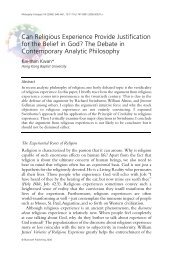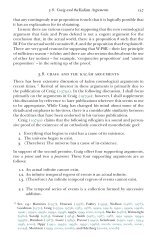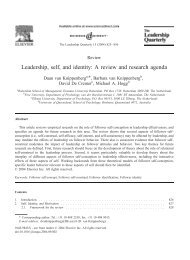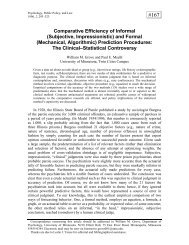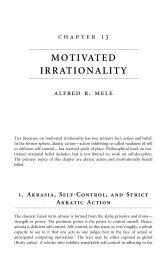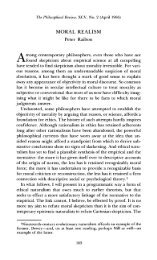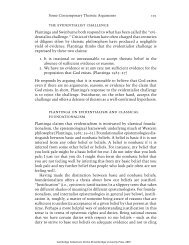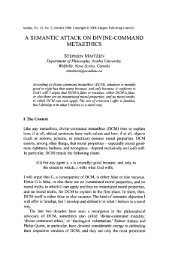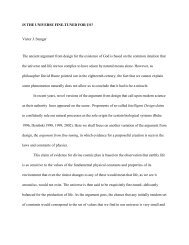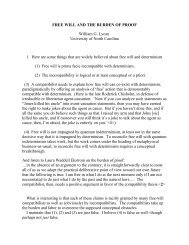Atheism and Theism JJ Haldane - Common Sense Atheism
Atheism and Theism JJ Haldane - Common Sense Atheism
Atheism and Theism JJ Haldane - Common Sense Atheism
Create successful ePaper yourself
Turn your PDF publications into a flip-book with our unique Google optimized e-Paper software.
<strong>Atheism</strong> <strong>and</strong> <strong>Theism</strong> 131<br />
undergoing modification, <strong>and</strong> in the narrower sense of not being subject to<br />
emotion. This reasoning also bears upon the first of the two point’s mentioned<br />
above, viz. the idea of divine simplicity. One reason why the activity<br />
of the first cause cannot derive from internal changes is that such an agent<br />
can have no moving (i.e. changing) parts; indeed it can have no parts at all.<br />
Once again it is important to be clear as to the nature of this claim. The<br />
doctrine of divine simplicity is not the thesis that God is relatively uncomplicated.<br />
Ordinarily when we describe something as ‘simple’ this is to contrast<br />
it in point of degree of complexity with other things. But God is not simple in<br />
this sense; rather the relevant contrast is between that which is composite <strong>and</strong><br />
that which is not. God can have no physical parts or else he would belong to<br />
the natural order <strong>and</strong> hence give rise to the same sorts of questions that<br />
initiate the five ways. Equally, he can have no metaphysical parts; that is to<br />
say God cannot coherently be thought of as composed of such elements as<br />
substance <strong>and</strong> attribute, or form <strong>and</strong> matter.<br />
In the case of things in the world there is a distinction to be drawn<br />
between features or attributes <strong>and</strong> that in which they inhere. On the one<br />
h<strong>and</strong> there is greyness, roughness <strong>and</strong> solidity, <strong>and</strong> on the other there is the<br />
subject of these, namely the stone. These features are of kinds that are or can<br />
be instantiated by other things. The stone, however, is a particular or individual<br />
<strong>and</strong> is not repeatable, though there may be others qualitatively indistinguishable<br />
from it. Moreover, while the stone may change its colour or<br />
become smooth, these sorts of changes in its attributes are different in kind<br />
from others, such as its being crushed, which would be equivalent to its<br />
destruction. Indeed, we can describe destruction philosophically as ‘change in<br />
respect of identity-constituting essential properties’.<br />
Similarly, in order to make sense of particular changes, <strong>and</strong> of change as<br />
such, we need to identify a medium of change. There are various c<strong>and</strong>idates<br />
for this but in keeping with the Aristotelian–Thomistic orientation of<br />
the present discussion let me introduce a metaphysical underst<strong>and</strong>ing of the<br />
notion of matter. In everyday parlance, when we speak of ‘matter’ we have in<br />
mind more or less solid stuffs like wood, plastic, stone or metal; or possibly the<br />
microphysical particles investigated by science. Since the Greeks, however,<br />
there has been another, philosophical, notion of matter which is correlative<br />
to the idea of form. In this sense every natural thing is a metaphysical<br />
composite of formal <strong>and</strong> material aspects. In other words everything is a<br />
combination of a set of one or more characteristics (essential <strong>and</strong> inessential)<br />
<strong>and</strong>, so to speak, an ‘occasion’ or ‘place’ of their instantiation. Further, the<br />
locus for a set of features or forms involves a series of possibilities. So, for<br />
example, the apple on the desk has a range of characteristics some of which<br />
can <strong>and</strong> others of which cannot change without its being destroyed. But these<br />
forms – colour, shape, texture, <strong>and</strong> so on – may be shared by another apple



